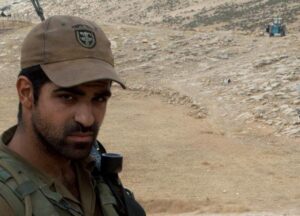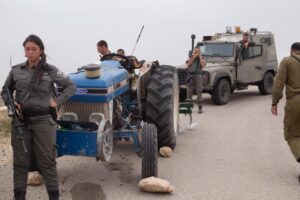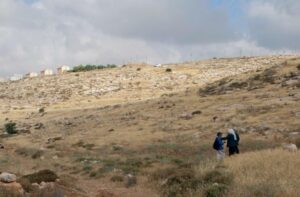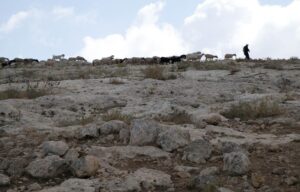GUEST ESSAY

 By Margaret Olin on May 7, 2024
By Margaret Olin on May 7, 2024
Click here to download this Essay as a PDF: A Day in the South Hebron Hills_MO_May24
I was asked to provide a commentary about Palestinian lives in the West Bank and Gaza, but I am not qualified to speak for Palestinians, and especially not for Gazans. I do feel competent, however, to speak about what it feels like to encounter the occupation for the first time in the West Bank as an outsider and to what one can learn from the encounter. My remarks will rely on my own experience, and because this experience was, and continues to be photographic, I also touch on the role that photographic witnessing may play in the ongoing struggles in Israel, the West Bank, and in Gaza.
The West Bank is the region known as “Area C,” the 60% of the West Bank which the Oslo accords designated as under full Israeli control to be gradually transferred to Palestinian jurisdiction, but which is instead increasingly being parceled out to Israeli settlers for the use of ever growing and multiplying settlements. The settlers push Palestinians off their lands and expel them from their villages, often violently. As a Jewish American, I knew and disapproved of these activities, but had never witnessed them.
A book on photographic practices, Touching Photographs, which I published in 2012, led me to take part in organizing a conference on photography at Tel Aviv University two years later. Before I even arrived, in May, 2014, I was already faced with a dilemma. The movement for Boycott, Divestment, Sanctions (BDS) was underway. It urged opponents of the occupation to take measures against Israel, among them to boycott Israel and refrain from collaborating with Israelis academically or culturally. Some participants dropped out of our conference in solidarity. I did not agree with the tactic then, and I still do not, but as I opposed the occupation, I decided to use the opportunity to find a subject in photographic studies linked to the occupation. I settled on spending some time after the conference researching the use of visual media by anti-occupation activists: one effort involved accompanying activists into the field, photographing them as they videotaped and photographed there, and then analyzing the visual practices that accompanied their work.
With this idea, I consulted an Israeli anti-occupation activist, the Sanskrit scholar David Shulman, who put me in contact with a group called Ta’ayush. In Arabic, Ta’ayush means living together. This all-volunteer group accompanies shepherds and farmers in the occupied Palestinian Territories to their grazing grounds and fields. Its members engage in non-violent direct action to offer Palestinians and Bedouins protection from Israeli settlers and soldiers who try to prevent them from reaching their lands. On May 31, 2014, I found myself boarding a bus in Jerusalem about six in the morning with a group of perhaps fifteen strangers: professors and staff members from Hebrew University, scholars, mathematicians, an architect, a filmmaker, therapists of various persuasions. Later in the field I would meet a poet, a performance artist, journalists, and several students.
I stuck to my plan, and started a blog, named touchingphotographs.com after my book, to work out my ideas on photographic practices. Initially, I thought I would write stories about quirky incidents, like a “cute meet” I once observed that involved a man taking a picture of an attractive young woman at a tourist site. As it turned out, however, I began with a post from that first day in the South Hebron Hills.
A small bus full of volunteers left Jerusalem about six in the morning for an area about an hour and a world away, known as the South Hebron Hills. A small group of us jumped off the bus in the middle of nowhere, climbed over a guard rail at the edge of the highway and were greeted by a beautiful panorama of rocky hills and green fields, scrambling down a slope like a rag-tag band of resistance fighters. At the bottom, beyond a shallow sewage ditch that some of us could hop over (not me; I accidentally stepped in), was a farmer, seated on a tiny tractor, plowing a tiny field, in a place called Wadi Sumsum. I contemplated this pastoral sight only briefly before I was interrupted by the rumble of heavy boots behind me and the metallic clank of weaponry, increasing in volume and intensity. The Ta’ayush volunteers had arrived just ahead of a group of Israeli soldiers who were descending the slope as rapidly as their heavy equipment would allow.

The soldiers surrounded the farmer. They seized the tractor and moved it to the gravel road that led to the top of the hill, where several soldiers guarded and inspected it as though they thought it might contain explosives. Its owner stood gravely nearby, fingering beads and handing over papers. Soldiers interrogated him about his rights to his land. They criticized his papers and told him that he would have to return next week with more, better papers. Eventually they banished him from his field. In the end, at the urging of the volunteer activists, I believe that the soldiers allowed him at least to keep his tractor. By then, it was about ten in the morning.

My post adhered to my original intent. It told the story in 12 photographs of the field, the soldiers, and the tractor. In many, but not all, of the frames, activists videotaped the interactions.

A brief text of 70 words, interspersed between the pictures, begins by saying that “A farmer plowing his field is a threat.” It suggests ways that soldiers counter the threat by immobilizing, surrounding, and inspecting the tractor, while volunteers point their only weapon, the camera, at the soldiers. The post ends by saying that the farmer points without any weapon.

As a reader, if you saw only these pictures and read this brief post, would you think of it as part of a treatise about how oppositional groups use visual practices? Surely the post concerns heavily armed soldiers preventing an unarmed farmer from plowing his tiny field. Which matters more? The treatise or the farmer? To me, the farmer’s plight was compelling even without any consideration of how volunteers might use visual media to document it. Yet there was more to this day that I did not include in my blog, that I had never encountered before, and that changed the direction of my practices, of my scholarship, and more.
It was my own interaction with the soldiers and the activists that affected me. The soldiers tried in vain to stop the activists from photographing. This included me. When he noticed some soldiers ordering me to stop photographing, a classicist yelled in my direction from a distance “Margaret. You can take pictures of whatever you want.” Before then, I had not much cared for the name, Margaret, that my parents gave to me, inspired by an obedient child they knew, and a sentimental film they had seen. Now Margaret was someone who stood up to authority, someone I aspired to be. The instrument that might enable me to become this new Margaret, I began to understand, was my camera.
The soldiers did not stop bothering me, however. They gathered about me, practicing their English, and telling me to “take your friends away from here.” I must have been the oldest activist that day, so they presumed I must be the leader. They did not know that I had just met all these friends for the first time that morning. I asked them “Why?”
Had I seen the article in the newspaper about some girls and cherries? Indeed I had . . . what about it . . . ? “That,” they boasted, “that was our unit!! We were the ones who did that. So take your friends away.”
The story, “Palestinian Girls detained for picking Settlers’ cherries,” recounted how four girls between the ages of 11 and 15, including one deaf girl, picked cherries from trees that they passed on their way home from school. They did not take any with them, but only ate some from the orchard as they walked by. I recognized the temptation. I myself had succumbed to it several times as a child when I attended a summer camp next to a cherry orchard. That the girls were detained for ten hours at the police station was insane enough. But what stayed with me was the pride that these armed men took in being a part of this. Were they excited that their exploits had made the newspaper? What planet had I landed on? Apparently, one where powerless girls were set upon both by soldiers and police for actions that barely amounted to a minor offense; and where an elderly farmer had to withstand humiliation from young soldiers weighed down by weaponry over the use of a tractor on a tiny field.
I would see it happen over and over in the field. A large number of uniformed men and sometimes women, in full army gear, are deployed to take harsh measures on unarmed farmers and shepherds for trivial or non-existent offenses, and, significantly, that to photograph or video such events is considered a threat. Indeed, visual witnessing of the occupation is considered a threat not only by soldiers, but by the government of Israel, as can be seen in efforts in the Knesset, in 2018, to criminalize the filming of Israeli soldiers with the intention of “undermining the morale of Israel’s soldiers and residents.” The bill also would have criminalized the sharing of such images on social media.

What followed my first day was a search, still underway nearly ten years later, for a way to tell the story of what was happening so as to impart to people who might see my blog the same feeling I had. I searched for a visual story-telling style depending on word-image relations. At first I tried using as few words as possible. An early post on Umm al-Amad used less than 100 words and 10 photographs to tell the story of an activist trying to convince a shepherd to bring his flocks through the wadi closer to the houses of the outpost above. He failed to convince the shepherd, who left.

Sometimes, over time, persuasion and non-violent intervention make a difference. While the landowner of the plot at Wadi Sumsum refused to return to his plot, when I visited Umm al-Amad several years later, I found shepherds grazing their flocks directly under those same houses, although still with soldiers and settlers watching them.

I continued to teach and write, but I also continued to photograph in Palestine. I came to know the villagers, farmers and shepherds whom I visited regularly. After a year, David Shulman, who had first put me in contact with the activist group, began to partner with me in the work. My role and my research project evolved. The day on which I had to acknowledge it had changed found me accompanying farmers who were replanting an olive grove that had been uprooted by Israeli settlers. With only one soldier looking at the ten of us from far away, there seemed to be little to do. I set my large camera down and asked a farmer what I could do to help with the work. Several other volunteers were at work. When he answered “you just take photographs,” I assumed that meant that there was nothing to do. But as I turned to join some volunteers who were sitting and enjoying the pleasant weather, he motioned me back. “No. I mean look. There. There are more soldiers. You must photograph.” I obeyed his order.
The farmer had a vision of what could be accomplished with my large camera. I do not know whether he had photographs in mind as an end product. But he understood better than I that the practice of photography is a form of extended, intensified attention. Photographic attention can be terrifying to those on the far side of the lens. The narrative of a video made by a right wing organization that sent moles to film members of Ta’ayush secretively attests to the brute power of video. I make a cameo appearance in the film about four minutes in as a threatening silhouette with a camera hiding my face, as a voiceover claims that the cameras attack “from zero range.” Our object is indeed that settlers might be afraid that the camera’s image will live to testify about what it saw, while farmers or shepherds acquire courage. My academic field research about photography had itself become a form of engagement. In fact, I eventually realized that my photographs were not so much an effort to impart information about what happened. What I wanted to show was the effect of engagement.
The kind of extended attention that visual witnessing demands, I realized, does not apply only when settlers are there to see the cameras. Also, it is important to witness the day to day lives, to witness and convey the pleasures of life – otherwise why try to stay on one’s land? – but also to try to convey the undercurrent of fear that governs all daily activities, even when there is no immediate threat. This points to the everyday danger involved in photographic activism, not physical dangers from settler violence, but the danger of misrepresenting the subjects one is trying to support, even, or especially, on uneventful days.
An example: The scene is a Bedouin village Umm al Kheir in South Hebron which is constantly under threat by the settlement right next to it. Buildings are constantly being demolished, rebuilt, and demolished again. Yet people feed their livestock and grow food; children go to school; an artist works in his studio; and life continues. I stopped by with a group of activists that day. One of them stood at the entrance to a modest shed of a home and pointed his cellphone down at a barefoot little girl to take a picture. Had I been there to study the ways in which activists use photography, I would have examined this photographic transaction. Instead, I found myself intervening in it. I put my hands on both his shoulders and pressed, exclaiming “get down”! He assumed that we must be under attack. That was reasonable given that attacks occur routinely. Some in our group had undergone one earlier that same day.
Having ruled out an attack, he then assumed I must be trying to help him make a good picture. Holding his phone vertically, he smiled and stooped down to take the picture. Then he showed it to me on his phone and said, “see, it’s still not a good picture.” Eventually he understood that I was trying to help him make not an aesthetically good but rather an ethically good picture, a picture that is not patronizing, that does not show a damaged child looking beseechingly at the camera. What would it mean to take such pictures, of, say, one’s grandchild?
Yet when I pushed my friend down to photograph a little girl instead of photographing from above, the resulting picture was perhaps less on my mind than the physical transaction itself between the two bodies, the activist armed with a cell-phone and the child at whom he points it. The picture is unlikely to travel beyond the cell-phone anyway. It’s the form of his engagement with, or attention to the child that was at stake – the relationship between Israeli activists and their Palestinian partners. The kind of knowledge these photographs impart would almost have to be the kind referenced in the phrase “knowledge is power.” The subject is the power of the person wielding the camera over the person on the other side of it.
The photograph attests to this relationship. The danger is that the photograph could suggest a child in immediate need of rescue, while the day that we were sharing was that in which a village went about a life worth preserving from the ravages of injustices by angry settlers, soldiers, or police. That day we were not protectors but rather companions, who shared lives and would return to the village on the basis of friendships made there, with the knowledge that our help would be forthcoming when requested.
For an activist, photography is always one or another form of engagement, for example solidarity with the oppressed or confrontation with the oppressor. Ta’ayush practices photographic watching extensively. If attacks occur, Ta’ayush members document them, and the images start to fly off the cellphone. But in the quiet moments photographic activism takes a different form, as an activist points a phone at a baby lamb.
I did indeed start thinking about photographic practices. I had written about how photographs form relationships but now I was thinking about how relationships form photographs. A photograph is a visible form of a relationship, or more accurately a performance of one.[1] Photography as a way of externalizing such performances, or forms, of attention. They are “forms” literally: The role of imagination in photographic practices, like the role of imagination outside of photography, is to turn attentiveness as a practice into a form, or image – an image of the relation between a watcher and an object or a person of interest. Considered in this way, photography pertains less to whatever external subject one might photograph than to the type of attention that one might direct toward or share with that subject, for example the kind of attention that offends or the kind that gives rise to friendship.
Since my last visit, before the war with Gaza began, several villages have disappeared, their inhabitants having fled or been driven out. Many of my friends on the west bank have fled their homes. I do not know where they are and what their lives are like now, and whether the shepherd of Umm al-Amad who was finally able to graze his flock again on the hill below the settlement had to give up and return to his limited grazing area again or worse. But visual witnessing continues to be a threat. In the present war in Gaza, it shows up in efforts to discredit journalists or keep them under control. This becomes painfully clear when there is little concern for whether the weapons of Israeli soldiers end up killing Palestinian journalists, such as Shireen Abu Akeleh or for the at least 88 journalists and media workers killed as of February 26 in Gaza; or when it is sometimes claimed that Gazan journalists who accompanied terrorists in the horrendous attacks in Israel had advance knowledge of the attack or even led terrorists to their prey, an accusation that forced international news outlets to take a defensive position. One of these photographers later won an award for his work, while the accusations continue. Fear of photojournalism is perhaps most apparent in the restrictions of foreign journalists, who can enter the Gaza strip only accompanied by soldiers who give them guided tours and set limits on what they can see.
But to view pictures of injustice, even of atrocity, over and over in the media is one thing. As threatening as this may be to the government committing them, it is something else again when one sees and reads the report of someone, perhaps much like some who are reading this report, who is personally encountering these injustices for the first time. I thought my companions wanted me to document and record, to show outsiders what was happening. But more than that, the significance of the work of a documentarist is simply to be a witness, to impart the effect of what is happening in front of one’s eyes, and therefore to invite viewers to look through those same eyes.
It can be transforming to recognize injustice through contact with it, but to feel the transformation through people who have been transformed by the sight of it can also be transforming. This is what is so hard to find, and so sorely needed, in Gaza.
FOOTNOTES:
1. See, for example, Margaret Olin, “Attentiveness and Visual Imagination in Looking and Photographing,” in Photography and Imagination, ed. Amos Morris-Reich and Margaret Olin (New York and London: Routledge, 2020) 118-132.
ABOUT THE AUTHOR:
 MARGARET OLIN
MARGARET OLIN
Senior Lecturer Emerita of Religious Studies, Yale University; Co-author “The Bitter Landscapes of Palestine”
Margaret Olin is a scholar, photographer and visual activist. She writes on art historiography, critical theory, Jewish art, spatial practices and most recently photography. Her publications include Forms of Representation in Alois Riegl’s Theory of Art (The Pennsylvania State University Press, 1992), The Nation without Art: Examining Modern Discourses on Jewish Art (University of Nebraska Press, 2001) Touching Photographs (University of Chicago Press, 2012). She co-edited with Amos Morris-Reich, Photography and Imagination (Routledge, 2019). She is the co-editor of Images: A Journal of Jewish Art and Visual Culture. Her photographs have been exhibited in the United States, Germany, and Israel. She is Senior Lecturer Emerita in the Department of Religious Studies at Yale University. She also runs a blog touchingphotographs.com that represents her efforts to comprehend the practices and powers of photography through words and images.
________________________________
Margaret Olin’s book of photographic texts, with David Shulman “The Bitter Landscapes of Palestine” will be published in 2024 by Intellect Press.